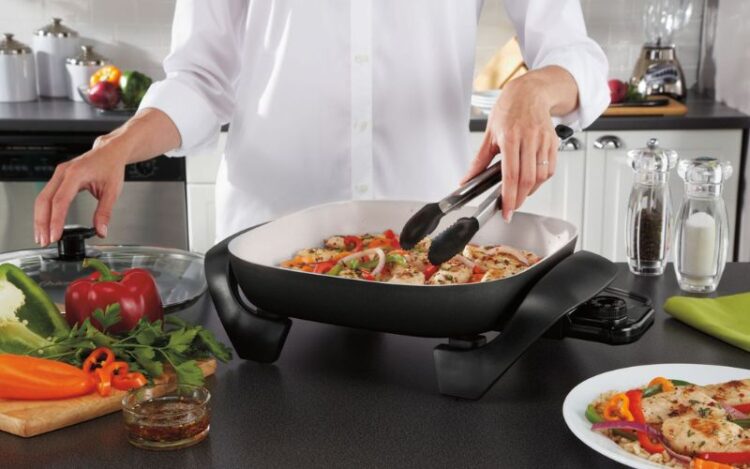Because of their usefulness and ease of use, electric skillets have become standard fixtures in today’s kitchens. Despite the importance of wattage in determining energy efficiency and cost savings, it is often overlooked when purchasing these products. Understanding the wattage of electric skillets is important, and we’ll go over the fundamentals of wattage, how to calculate it for individual skillets, and the benefits and drawbacks of utilizing skillets with varying wattages in this post.
Energy Efficient Cooking
Kitchen appliance energy efficiency is especially important in today’s environmentally conscious and economically constrained world. To produce heat, electric skillets use electricity in the same way as any other electric appliance would. If you are concerned about your environmental impact, you should know the wattage of your electric skillet. You may help the environment and save money on power by switching to a low-wattage skillet for chores that don’t require high heat.
Cost Savings of Using a Wattage-Specified Approach
You may save a lot of money by learning about the wattage of your electric skillet. Using a high-wattage skillet when a lower-wattage one will do the job just as well is a certain way to drive up your monthly electricity costs. In contrast, high-temperature cooking in a low-wattage skillet could take longer and use more power. You may minimize wasteful energy consumption and save money on monthly electricity costs by adjusting the wattage of the skillet to your individual cooking needs.
Basics of Wattage and Electric Skillets
What is Wattage?
The wattage of an item is its measured electrical power output or input. When discussing electric skillets, wattage refers to the amount of energy required to reach and maintain the set temperature. It’s important because it affects how well and how efficiently the skillet cooks.
Overview of Electric Skillets
Cooking in an electric skillet is quick and easy, and you can use it for a wide variety of foods. While their shapes and sizes vary, most of these appliances feature a flat, rectangular, or circular cooking surface with knobs for adjusting the heat. The electric heating element in the skillet responds to the user’s input on the desired cooking temperature and produces the necessary heat.
Determine the Power Requirement of Your Electric Skillet
Primary Considerations for Determining Electric Skillet Power Consumption
Several important aspects must be taken into account when determining the wattage needed for an electric skillet.
The amount of power a skillet requires depends in large part on its cooking surface size. To provide uniform heating over a larger surface area, the wattage of a larger skillet is often higher.
Electric skillets are available in a wide variety of temperature levels and control options. The wattage of a skillet might be higher if it has a broader temperature range or more accurate control options.
Some Typical Electric Skillets and the Amount of Power They Require (at Various Temperatures)
Some examples of how various elements influence the wattage of electric skillets are provided below.
Power requirements for a small (8-10 inch) skillet are typically about 1000-1200 watts.
Medium Skillet (12-14 inches): Generally varies from 1200 to 1500 watts.
The power requirements of a large skillet (16 inches or more) are at least 1500 watts.
Power levels for high-temperature range skillets (450°F and above) average approximately 1500 watts.
Possible lower wattage, around 1000-1200 watts, for low-temperature range (200°F – 350°F) skillet.
With this knowledge in hand, you can choose the best skillet for your cooking needs and save your energy bill at the same time.
Advantages and Disadvantages Of Using Electric Skillets of Varying Wattages
Benefits of Using a Skillet with a Higher Wattage
Shorter Preparation Times: Skillets with higher wattages reach cooking temperatures more rapidly.
Searing and frying at high temperatures are just the beginning of what they can do.
Even Heating: Large, high-wattage skillets heat their surfaces uniformly.
Disadvantages of a Skillet with More Wattage
They use more power, which could increase your monthly expenditures for electricity.
Some high-wattage skillets may have restricted temperature-regulating choices, making precision cooking more of a challenge than it should be.
Benefits of Cooking with a Lower-Wattage Skillet
If you don’t need a really high temperature, it’s more efficient to use a skillet with a lower wattage.
Financial Gains: Lower electricity use means lower monthly expenses.
Disadvantages of Using a Skillet with a Lower Wattage
They may heat and cook food more slowly, which could be an issue for recipes that need to be prepared quickly.
Lower wattage skillets may struggle with operations like searing or frying at high temperatures, limiting what you can cook.
Conclusion
To cook efficiently and save money on electricity, you need to know how many watts an electric skillet uses. You may minimize your carbon footprint and energy costs by selecting a skillet with the appropriate wattage for your cooking needs.
Making well-informed decisions regarding your kitchen appliances can lead to more environmentally responsible and financially friendly cooking methods, whether you prefer the versatility of a high wattage skillet or the efficiency of a lower wattage one. The next time you use your electric skillet to cook a meal, keep in mind that understanding your wattage is the key to a more sustainable and affordable kitchen.

